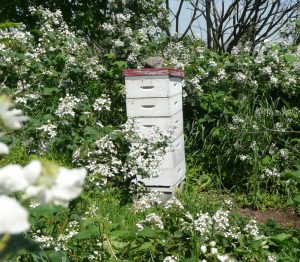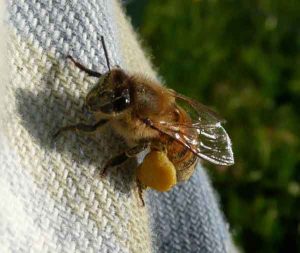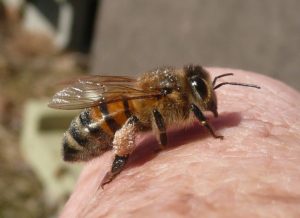Live from the Hive: June 2013
“Blossoms to Berries” By Annie Watson
June is the month when the wild berry plants blossom here in the north country. As I write, blackcaps (aka black raspberries or rubus occidentals) are blooming. This unassuming little flower is a big favorite of honey bees. The first blackberry (rubus alligheniensis) flowers are about to open. When the patch by our beehives is in full bloom, it looks like a beautiful May snowstorm all around the beehives.
 Now is the time, when the white flowers make them easy to spot, to locate your wild blackberry patches at the edges of fields and in the meadow. Note where they are so you can come back and pick the fruit in July. Look for the first ripe berries about a month after flowering — and thank the bees and other pollinators, because without them, there would be no summer fruit, purple, sweet, and juicy on a hot summer day.
Now is the time, when the white flowers make them easy to spot, to locate your wild blackberry patches at the edges of fields and in the meadow. Note where they are so you can come back and pick the fruit in July. Look for the first ripe berries about a month after flowering — and thank the bees and other pollinators, because without them, there would be no summer fruit, purple, sweet, and juicy on a hot summer day.
 For the past two days the bees have been coming in absolutely loaded down with bright yellow willow pollen and grey red maple pollen. I wonder how they can even get airborne, the pollen baskets on their back legs are so encumbered with huge blobs of the stuff. It’s funny to watch them as they arrive on the landing board and waddle into the entrance with their booty.
For the past two days the bees have been coming in absolutely loaded down with bright yellow willow pollen and grey red maple pollen. I wonder how they can even get airborne, the pollen baskets on their back legs are so encumbered with huge blobs of the stuff. It’s funny to watch them as they arrive on the landing board and waddle into the entrance with their booty. The bees were busy in the warm weather yesterday. The workers came back to the hive looking like they’d spent some time in a bakery — all dusted with very light tan pollen. It could be red maple, or maybe elm — I’m not sure. Red maples bloom around this time. Now, on warm days, the bees can feed their young, and the more food that’s available the more numerous and stronger the colony will be come summer. Nectar and pollen producing plants promote brood rearing and wax production — both important to the “spring buildup” of the colony.
The bees were busy in the warm weather yesterday. The workers came back to the hive looking like they’d spent some time in a bakery — all dusted with very light tan pollen. It could be red maple, or maybe elm — I’m not sure. Red maples bloom around this time. Now, on warm days, the bees can feed their young, and the more food that’s available the more numerous and stronger the colony will be come summer. Nectar and pollen producing plants promote brood rearing and wax production — both important to the “spring buildup” of the colony.